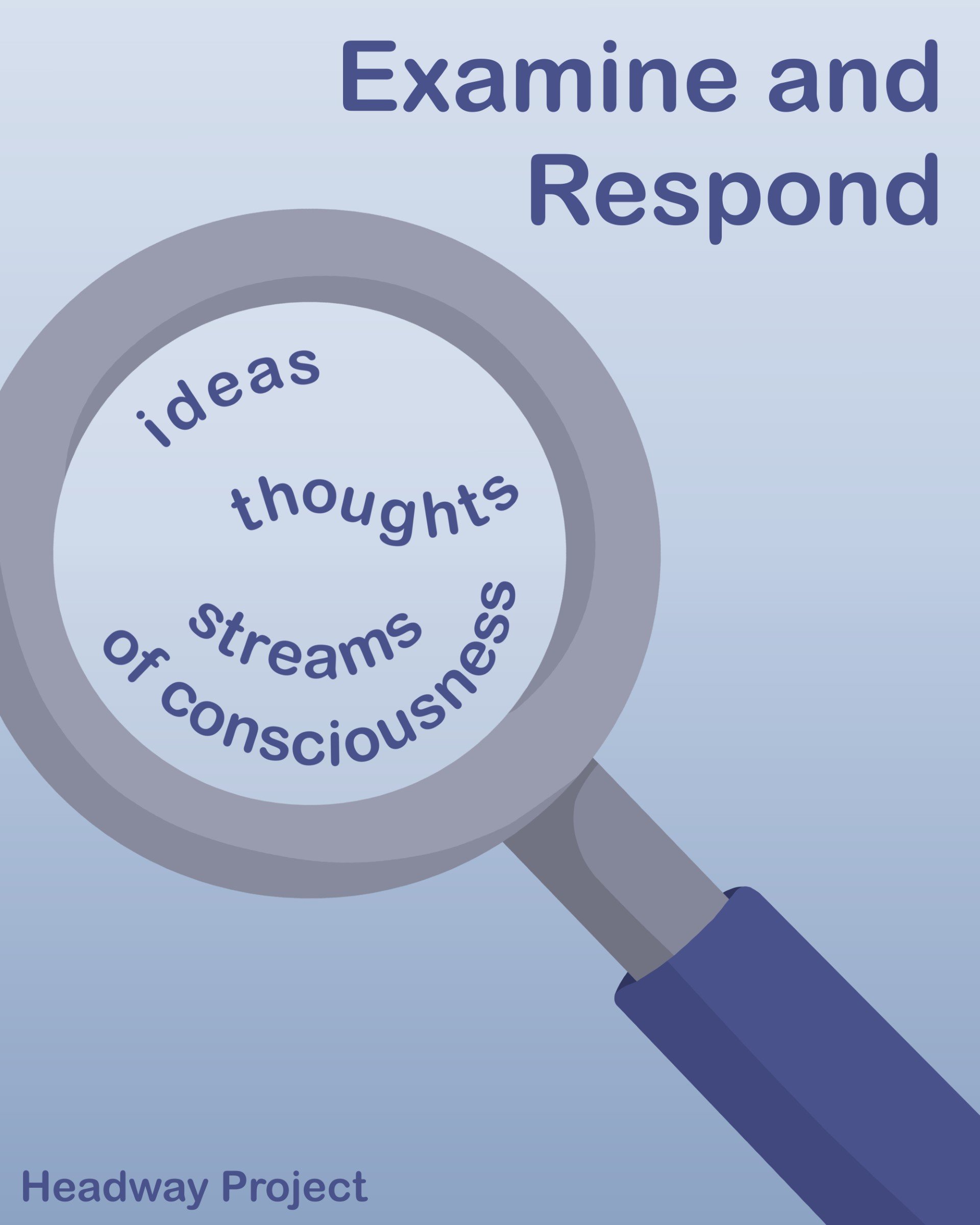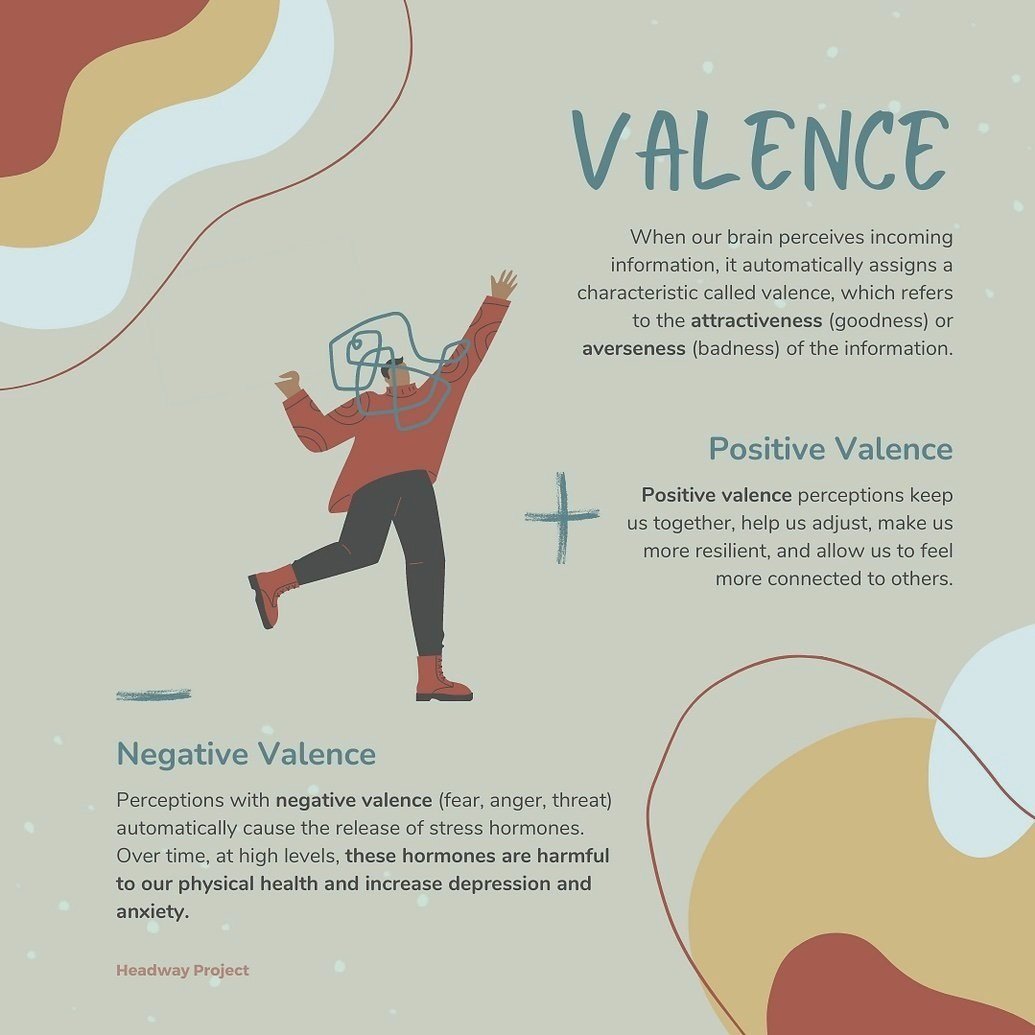
Thoughts Are Just Thoughts
But They Make Us Who We Are

How is your Headspace?
Our thoughts create the headspace in which we live.
A healthy headspace is when you feel content and at peace wherever you are, and you do not want to be anywhere else.
A negative or unhealthy headspace is when you are frequently angry, frustrated, or unhappy. Your negative self-talk causes feelings of inadequacy and self-criticism. You are more prone to worry and to ruminations that make you feel socially isolated. You might have physical symptoms of fatigue, tension, or stress.
Managing Thoughts helps you create a healthy headspace.
How we think and perceive the world directly influences our mental and physical health. Thoughts can be healthy or highly destructive.
Thoughts are not reality; they are a person’s view of reality.
Remember:
1. Thoughts are just thoughts (we choose how we respond to them).
2. Thoughts change the way we see things.
3. Thoughts change how we feel.
Try this: Think of something funny ….., something that made you sad……., something that made you happy………… Notice how different thoughts change the way you feel in this moment. Thoughts are powerful; they change the chemistry inside your body and alter how your brain works from moment to moment.
When we learn to notice thoughts without automatically reacting to them, we become less controlled, more open to change, and develop the ability to see things more clearly. Thoughts are just one source of information; they do not control us unless we let them. Thoughts are influenced by perceptions, but managing thoughts helps us develop healthy perspectives. Managing thoughts more effectively improves our health and wellness, helps us coexist more peacefully with others, and helps us care for our planet!
Managing thoughts is a skill that can be refined over time. Don’t worry if it’s hard at the start; everyone must practice skills to make them better and we all have flawed perceptions.
Becoming aware of how our thoughts influence us is a step toward learning how to manage them. Awareness or noticing thoughts is known as metacognition, and it is a step toward insight into how our thoughts impact us.
Managing Thoughts also helps us with other skills like managing Emotions, Attention, Connections, and Health more effectively. These areas work together to help you achieve an authentic and well-balanced life. The T E A C H program connects you with practical knowledge in all of these areas.

SIX PRINCIPLES TO HELP YOU CREATE A HEALTHY HEADSPACE

1. Willingness To Change
Allow Your Headspace to Grow:
By nature, we are constantly changing creatures. You can feel one way in one moment, then feel differently, and then back to how you were. The point is that we are continually changing creatures; that is how we adapt to changes in the world. Change comes from inside and out and can help us cope with life. When healthy, we grow by moving out of our comfort zone and adjusting to the necessary changes. Changes in our thinking start the growth process. Thought patterns can change in helpful ways if we are willing to cultivate change and embrace the natural growth that occurs when we accept change and allow ourselves to grow.
Adaptation to Change
Life Begins on the Edge of Your Comfort Zone
Be Willing to Embrace Change
“Who Moved My Cheese,” By Spencer Johnson, M.D., is Amazon’s all-time #1 bestselling book. It is a parable about two mice and two “little people” who live in a maze and spend their days looking for cheese (sustenance). When the cheese disappears, the characters react differently: some resist change and become stuck in their ways, while others are willing to adapt and find new opportunities. This interesting little story teaches us how important it is to embrace change, adopt a more positive mindset, and take action.
-
Thoughts, like other behaviors, are influenced by the way we attend to them—if we react emotionally or give certain types of thoughts too much attention, they tend to stick around or get stronger. It’s essential to listen to our thoughts, but giving thoughts the right kind and amount of attention is vital. Give more attention to positive or helpful thoughts and less attention to thoughts that create stress or negative emotions.
-
When we encounter a new situation and are required to determine a response, cognitive flexibility also allows us to consider many options. That is the difference between reacting impulsively and responding skillfully. Like any other skill, this requires practice.
We are flexible beings, and we do not need to think alike. Diversity and freedom of expression are beneficial. We need to examine our thoughts and be flexible enough to ask questions, determine if there's a better way to manage our situations in life, and develop more healthy mindsets.
Tuning into this flexibility helps us manage our relationship with our thoughts and change our lives.
-
Given that we're constantly changing, it's important to remember that our brains won't always function perfectly—we can get stuck, misunderstand, misperceive, and think of things that turn out to be wrong or false. If we don't question our thoughts, we'll likely be misled by clever advertisements, false statements, or illusions we want to believe.
“We cannot solve our problems with the same kind of thinking that we used when we created them.” Albert Einstein

2. Challenge Unhealthy Thoughts
Repetitive thoughts become patterns of activity in the brain. Many thought patterns that originate in childhood are carried into adulthood. When we do not re-examine our thoughts as we grow, we treat our thoughts like an uncultivated garden. When we challenge our unhelpful notions and ideas, we become conscientious, deliberate gardeners, and our thoughts bloom healthily. Learning to challenge what you think rather than accepting thoughts blindly is essential. Thoughts are just thoughts; careful examination helps us determine which ones are helpful and most deserving of our attention and are up to date with our knowledge and experience. This process can be thought of as updating the reward value of our thoughts and behaviors; it is a necessary part of growth and restoration. Some might call this developing a new perspective.
Challenge What You Think; You Cannot Always Be Correct

3. All Perception Is Misperception
What you say to yourself and what others say to you may or may not be accurate. You are more likely to find the truth if you remember that your thoughts, memories, and perceptions are just predictions and representations of reality. They are not reality, and they are never completely accurate. This is the opposite of believing with certainty that you are always right. Multiple things can be true at the same time and they may not always seem to fit together. Awareness that you might not see the truth clearly helps you see the truth more clearly. Five people looking at the same thing will have five different stories, so how do we figure out what actually happened? The answer lies in questioning, the art of not knowing and knowing that you do not know. This creates space around thoughts in which helpful feelings, perspectives, and insights can arise.
Knowing we cannot be sure what we think is entirely accurate or always beneficial holds us together in our collective humanity. Awareness of this imperfection can be helpful; we can rest in the comfort of knowing we are not alone with our distressing and frequently very wrong thoughts. Accepting that everyone struggles with thoughts and emotions can level the playing field and keep us from feeling isolated, different, or wrong.
Once we accept that we may not be thinking or perceiving correctly, we are still faced with trying to understand how our ideas, thoughts, or streams of consciousness might complicate our lives and that of our loved ones. To manage thoughts is to notice, question, and examine them before automatically reacting to them. This is the art of responding vs. reacting.
“There is a space between stimulus and response and in that space, we have the right to choose and that choice determines our destiny.” Attributed to Viktor Frankl, Austrian psychiatrist and philosopher.

4. Your Thoughts Change How Your Brain Works
We all have an amazing superpower known as neuroplasticity. Just like muscles in the body change when we do physical exercise, our brains change in response to our thoughts and actions. The more specific thought patterns are used, the stronger the connections between the neurons associated with that thought become. We can use our minds to literally change our brains.
-
Life experiences change the brain's structure and function, as well as the way the brain and body interact. Our daily experiences change the physical architecture and patterns of communication between relevant regions of the brain that regulate thoughts, emotions, and behavior. You change your brain's size, shape, or function through the way you think about your life. This is unavoidable. Neuroplasticity refers to the brain's ability to modify, change, and adapt both in structure and function throughout life and in response to experience. It’s our brain’s constant state of change. We all have this fantastic superpower!
-
If interconnected neurons become very active very close in time during a particular event, their connection will strengthen, and a memory of this event is formed; in other words, neurons wire together if they fire together, and when they fire together, they often become stronger and create more connections. In turn, they’re triggered more easily.
-
It is possible that the process of neuroplasticity can explain how certain mental health disorders, such as anxiety and depression, develop over time. These conditions are not usually a result of a disease process but instead changes in the brain due to the interplay between genes and the environment. By using the knowledge of neuroplasticity, we can make changes to correct conditions or areas of the brain that are out of balance.
All of this is a lot of information to handle. Great job for tackling what you have!
What You Practice Grows Stronger
The good news is that negative thinking patterns can be unlearned and replaced with healthier thoughts (different circuits or networks). To do this, we must consciously and deliberately activate circuits that positively impact the brain (healthy perspectives). Just like a toddler learning to walk by getting up and trying repeatedly, we can develop and strengthen positive circuits by practicing new emotional habits, thought patterns, and physical or social skills.
Conversely, when we have unhealthy thoughts or if we don’t manage thoughts well, we unknowingly change our brain's architecture in unhealthy ways.

5. Thoughts Influence Emotions And Physical Health
Thoughts and physical health interact. The person who thinks the world is unfriendly will see more danger than the person who sees the world as friendly. What we think about and how we perceive the world directly influences our mental and physical health. Wars have started, people have been enslaved or killed, and our planet has been put at risk because of how people think. Individual thoughts determine how we live our lives, how we feel, and how we care for ourselves. Thoughts are powerful. When we step back and look closely at our thoughts, we can determine how they might be helping or hurting us individually and what we can do to manage them more effectively. When we notice and observe our thoughts and focus more on healthy thoughts, we can manage our lives more effectively, improve our health, and coexist more peacefully with others.
Thoughts Have A Positive or A Negative Valence
“Thoughts become perceptions; perceptions become reality, alter your thoughts, alter your reality. ”
Valence is the subjective positive or negative value an individual assigns to an object or situation. It is important because it measures an individual’s emotional response to a stimulus and influences their attitude, behavior, and decision-making process.
This automatic response to incoming information causes the release of positive or negative endorphins, hormones, or neurotransmitters, powerful chemicals that can help us cope with stress.
“ The moment you change your perception is the moment you rewrite the chemistry of your body.”
-Dr. Bruce Lipton
Valence is important to know about because it happens automatically. It is based on experience with that or similar information. Awareness of valence helps us notice these biological reactions and respond skillfully rather than react automatically.

Have you ever been “lost in thought?” This is when you pour the coffee creamer into the sugar bowl or end up in a room or a situation where you do not know why you are there. Getting caught up in our internal world of confusing thoughts can be exhausting. Overthinking can create confusion, clutter, and noise in our heads and keep us from seeing all the available options. Sometimes, we try to think harder to solve problems that thoughts cannot fix. This causes our minds to race, we have difficulty turning off thoughts, and the body's stress response system kicks into gear.
New information comes to us from the outside world, not from rehashing or thinking what we already know or think we know. We struggle with choices or decisions because we often need more information, and thinking more will not give us this new information. Our mind is typically described as the total flow of information available to us at any time; thoughts are usually just an editorial narrative, one piece of this total flow of information.
Listening to or observing others or tuning in to our bodies allows us to discover solutions we might not see otherwise. Answers are often found in stillness, letting our thoughts settle, and tuning in or noticing what is happening around us. Solutions often come from your heart or someone or something you notice in the world around you.
Sometimes, we are not even focused on the solution when we find it. When we let our minds be free from the problem, we can see more clearly. A walk in the park or reading a good book might bring clarity to our minds. By letting go of thoughts, we may see the problem from a different angle, or by not focusing too intently on our thoughts, we allow new ideas to emerge.
6. Overthinking

Material Taken From
David Burns M.D., How to Feel Good, The New Mood Therapy
The Extended Mind , Anne Murry Paul
Who Moved My Cheese, An Amazing Way to Deal With Change In Your Work and In Your Life. Spencer Johnson M.D.






